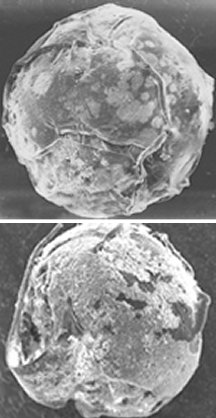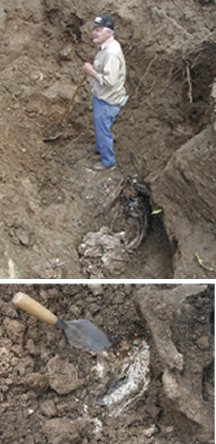First Steps
Modern science investigates the initial stages of how fossils form
Imagine that during a tour of the paleontology wing of a museum, a group stops to gaze upon a 150-million-year-old fossil of Archaeopteryx, the world’s first bird. “Only 10 of these have been discovered since the species was first described in 1861,” says the guide. “Amazing,” a tourist marvels. “I wonder why there are so few.” Simultaneously, a paleontologist standing nearby is thinking, “I wonder why there are any at all.”



Archaeopteryx fossils may be rare, but those that scientists have collected preserve the ancient creature intact, or nearly so. The creature’s delicate skeleton and feathers show up clearly. They’re encased in limestone presumably derived from the layered, fine-grained sediments that accumulated on the bottom of an ancient lake. But modern birds don’t usually end up in peaceful repose on lake bottoms. If the birds die over water, their light carcasses typically float until they rot. Now, researchers who’ve conducted field experiments with a couple-dozen dead birds and a little mud say that they’ve come up with a scenario that may explain how such fossils get their start.
Mystery underlies the fossilization not just of birds but of most animals. Some teams of scientists are now using lab and field tests to investigate how postmortem processes affect animal tissues of various types and sizes, from crustacean embryos to elderly rhinos. In doing so, they’re gaining insights into the fossilization process. That information may lead to more-accurate interpretations of the fossil record and reveal new views of ancient creatures and their environments.
Stick in the mud
Most organisms live, die, and disappear without leaving any hints that they ever existed. Some creatures, however, leave behind trace fossils, such as their burrows or their footprints (SN: 6/9/01, p. 362: Beyond Bones; 1/7/06, p. 3: Stone Age Footwork: Ancient human prints turn up down under). In rare cases, biological remains survive scavengers and decomposition, become buried, and evade geological processes such as erosion. These are the remains that become fossils—either by making an impression in rock or by themselves turning into rock.
Most carcasses that harden into fossils, including those of birds, were deposited in a body of water and then buried by sediment, says David A. Krauss, a paleobiologist at City University of New York. However, the irksome fact that dead birds float conflicts with this observation. In fact, bird carcasses float for quite a while, according to the results of experiments conducted by Krauss and his colleagues. The researchers reported their findings last October at a meeting of the Society of Vertebrate Paleontology in Mesa, Ariz.
In their tests, conducted outdoors during the summer, Krauss and his colleagues placed carcasses of doves, swallows, and blackbirds in tanks filled with water. Every one of the dozen birds floated. By the end of the third day, a thick film of bacteria had formed on the carcasses. Soon thereafter, the birds’ remains became infested with bugs and maggots. Over the next 3 to 4 weeks, the carcasses decayed, lost some feathers, and began to fall apart—but they still floated.
Only after decomposition breached the birds’ internal air sacs and permitted water to flow into those cavities did the body parts finally sink, says Krauss. At that point, the remains certainly wouldn’t have made informative fossils.
After some experimentation, the researchers found a way to overcome a dead bird’s buoyancy. When a carcass was dropped onto moist sediments that contained clay, the material soaked into the bird’s feathers and bound the body to the mud in just a few minutes. Later, when water was added to the tank, the stuck-in-the-mud carcass remained submerged.
Taking their work even further, Krauss and his team added enough sediment to the tanks to bury the submerged carcasses. Then, they placed weights on the mud to increase the pressure, as a naturally buried body would experience if accumulating lake sediments gradually covered it. The team left the bodies in place for 3 years.
When the researchers unearthed their samples, they found that the patterns and extent of preservation of the faux-fossil birds were remarkably similar to those seen in actual fossils millions of years old. This resemblance suggests that the remains of ancient birds might have begun their process of fossilization in just such a way, Krauss notes. The team’s findings may enable scientists to better interpret fossils and deduce the environments in which they formed, he adds.
Tough eggs
Some body parts, such as bones and teeth, have a good head start on fossilization because they contain significant amounts of long-lasting minerals. Soft body parts, by contrast, typically succumb to decomposition. However, even the flimsiest of tissues can become fossils if environmental conditions are right.
In 1998, for example, scientists reported finding fossils of two- and four-cell embryos. These fossils, less than a millimeter across, turned up in rocks derived from marine sediments deposited about 570 million years ago (SN: 2/7/98, p. 84).
Ancient arthropods or their predecessors were probably the source of the embryonic remains, says Derek E.G. Briggs, a paleontologist at Yale University. He and his colleagues conducted lab experiments to see whether they could replicate the fossilization of these gelatinous tissues.
The researchers took eggs of several modern-day aquatic crustaceans and placed them in glass vials that contained a fluid resembling seawater. To some of the vials they added extra phosphate because the rocks that had yielded the ancient embryos were rich in that mineral. To simulate the burial of eggs by the creature that laid them, the researchers added to many of the vials sediment taken from an estuary. All the vials were crimped shut and then stored at 15°C.
Bacteria naturally present in all the samples fed on available nutrients, including the eggs. In less than a day, that activity robbed the water of its oxygen and the bacteria died, so no further decomposition occurred.
The release of hydrogen sulfide, carbon dioxide, and small amounts of fatty acids during the brief period of decomposition caused the water to become more acidic, says Briggs. That, in turn, set up conditions in which dissolved carbonate and phosphate minerals could more easily precipitate from the solution and accumulate on what remained of the eggs and on other surfaces.
Only in one set of environmental conditions—that in which many European lobster eggs were buried in sediment—did eggs acquire a complete coating of minerals. However, some tests with apparently identical environmental conditions failed to produce mineralized eggs, Briggs notes. Even within a single vial, effects sometimes weren’t consistent: Some eggs had patches of minerals on their exteriors, while others ended up with none. Briggs and his colleagues report their findings in the December 2005 Palaios.
Although the details about what triggered the mineralization of eggs remain elusive, the tests show the important role that oxygen depletion and low pH play in the process, says Briggs.
In some cases, the coating was visible after just 2 weeks. Most tests lasted no more than a couple of months, but several ran for 10 months or more. Even after that period, mineralization showed only on the eggs’ outer surfaces, not within them.
Mineralization of an egg’s contents must take longer than the experiments had run, says Briggs. However, the team’s findings suggest that eggs can remain intact in sediments at least a year, if not longer. In essence, fossilization is a race between the processes of mineralization and decay, he notes.
Big mummy
In 1983, in a remote site on the campus of the University of Wisconsin–Madison, a small group of people buried the headless carcass of a white rhino. Neither a fraternity prank nor part of a voodoo ritual, the interment was the first step in an experiment to study the decay and decomposition of a large animal.
The rhino, which had been donated to one of the university’s museums after it died in a nearby zoo, was buried on its side in sandy soil at a depth of about 2 meters, says paleontologist Joe Skulan. Soil temperature at that depth was a nearly constant 7.3°C. The soil was well drained, so oxygen could reach the carcass, but it was also perpetually moist. This combination of conditions maximized the rhino’s rate of decay but minimized damage to its carcass from freeze-thaw cycles and the growth of plant roots, says Skulan.
When the scientists unearthed the carcass in the early 1990s, they found that its hind limbs were detached from its body. After taking a few tissue samples, they reburied the rhino. Then, when the scientists dug up the rhino in the spring of 2002, they found that much of the flesh from the creature’s rear legs and lower front legs had disappeared. However, muscles from the creature’s forelimbs and shoulder had not only escaped degradation, but were moist, pliable, and bright red—”like [they] came out of a butcher’s shop,” says Skulan.
Fragments of the leathery toe pads from the creature’s front feet were still present, but most of the rhino’s skin was missing. The rhino’s internal organs had dehydrated and shrunk within its body cavity, which hadn’t collapsed despite the weight of the overlying soil. That body cavity was surrounded by a thick layer of adipocere, a hard, grainy substance commonly known as grave wax. Adipocere often forms in cool, moist environments when chemical reactions crosslink fat molecules in a body, which makes them into a soap.
Among preserved remains of ancient humans, so-called soap mummies are much more common than the desiccated mummies that people typically think of, says Skulan. This kind of preservation may also explain the formation of fossils known as mummified dinosaurs, which preserve considerable volumes of soft tissue such as muscle and cartilage as well as bones, he notes.
In the spaces between vertebrae and other bones of the buried rhino, the researchers found crystals of a mineral called struvite, a hydrated version of ammonium calcium phosphate. The ammonium ion in the compound comes from the decomposition of nitrogen-rich organic material, says Skulan. As such, the presence of struvite—or minerals that derive from it—near fossilized bones may be a sign that remnants of soft tissue have also been transformed into struvite and thus preserved.
“There’s a lot of bad information out there about fossilization,” says Skulan. “If you look at the modern descriptions of fossilization, they’re the same as the ones included in the 1795 Encyclopedia Britannica.” Only in the past decade or so have people begun to study in detail what happens to organisms after death, he adds.
Because plants and animals produce such a variety of tissues, Skulan says that there’s no single route that scientists can identify as fossilization. In a sense, fossilization is as much a process of elimination as an active means of preservation.
“We need to look not at how tissues are preserved but at how they’re destroyed,” Skulan notes. “Because bones are already highly mineralized, they’re already mostly rock. Unless something happens to destroy [that bone], it’s gonna persist. … If a buried bone lasts 10 years, most of the things that can happen to it have already happened.”







